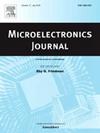基于自适应体偏补偿技术的宽功率动态范围CMOS射频能量采集整流器
IF 1.9
3区 工程技术
Q3 ENGINEERING, ELECTRICAL & ELECTRONIC
引用次数: 0
摘要
提出了一种用于射频能量采集的新型宽功率动态范围CMOS整流器。在该结构中,采用自适应体偏置补偿(ABBC)技术来扩展整流器的功率动态范围。这是因为ABBC技术可以使主整流晶体管的阈值电压根据输入功率的变化动态调整。当输入功率较低时,所提出的基于abbc的整流器相当于传统的交叉耦合整流器。因此,在这种情况下,所提出的整流器实现了良好的功率转换效率(PCE)。相反,ABBC技术在高输入功率时可以提高主整流晶体管的阈值电压。因此在输入功率较大时也具有良好的PCE。为了验证,我们在标准0.13 μm CMOS工艺中设计了433 MHz整流器。后置仿真结果表明,其峰值PCE为83.6%,灵敏度为-19.1 dBm。在100 kΩ负载(RL)下,PCE>; 40%和PCE>; 20%的动态范围(DR)分别为15.1 dB和26.4 dB。本文章由计算机程序翻译,如有差异,请以英文原文为准。
A CMOS rectifier with wide power dynamic range based on adaptive body bias compensation technique for radio frequency energy harvesting
This paper presents a novel CMOS rectifier with wide power dynamic range (WPDR) for radio frequency energy harvesting (RFEH). In the proposed structure, an adaptive body bias compensation (ABBC) technique is employed to extend the rectifier’s power dynamic range. This is because the ABBC technique can be used to make the main rectifying transistors’ threshold voltage can be dynamically adjusted according to the input power variations. The proposed ABBC-based rectifier is equivalent to a conventional cross-coupled (CC) rectifier when the input power is low. Thus, in this case, the proposed rectifier achieves a good power conversion efficiency (PCE). On the contrary, the proposed ABBC technique can increase the threshold voltage of the main rectifying transistors when it has a high input power. Therefore, it also has a good PCE when the input power is high. For validation, we design a 433 MHz rectifier in a standard 0.13 m CMOS process. The post-simulated results show that it achieves a 83.6 % peak PCE and a -19.1 dBm sensitivity. Besides, its dynamic range (DR) for PCE >40% and PCE> 20% with a 100 k load () are 15.1 dB and 26.4 dB, respectively.
求助全文
通过发布文献求助,成功后即可免费获取论文全文。
去求助
来源期刊

Microelectronics Journal
工程技术-工程:电子与电气
CiteScore
4.00
自引率
27.30%
发文量
222
审稿时长
43 days
期刊介绍:
Published since 1969, the Microelectronics Journal is an international forum for the dissemination of research and applications of microelectronic systems, circuits, and emerging technologies. Papers published in the Microelectronics Journal have undergone peer review to ensure originality, relevance, and timeliness. The journal thus provides a worldwide, regular, and comprehensive update on microelectronic circuits and systems.
The Microelectronics Journal invites papers describing significant research and applications in all of the areas listed below. Comprehensive review/survey papers covering recent developments will also be considered. The Microelectronics Journal covers circuits and systems. This topic includes but is not limited to: Analog, digital, mixed, and RF circuits and related design methodologies; Logic, architectural, and system level synthesis; Testing, design for testability, built-in self-test; Area, power, and thermal analysis and design; Mixed-domain simulation and design; Embedded systems; Non-von Neumann computing and related technologies and circuits; Design and test of high complexity systems integration; SoC, NoC, SIP, and NIP design and test; 3-D integration design and analysis; Emerging device technologies and circuits, such as FinFETs, SETs, spintronics, SFQ, MTJ, etc.
Application aspects such as signal and image processing including circuits for cryptography, sensors, and actuators including sensor networks, reliability and quality issues, and economic models are also welcome.
 求助内容:
求助内容: 应助结果提醒方式:
应助结果提醒方式:


